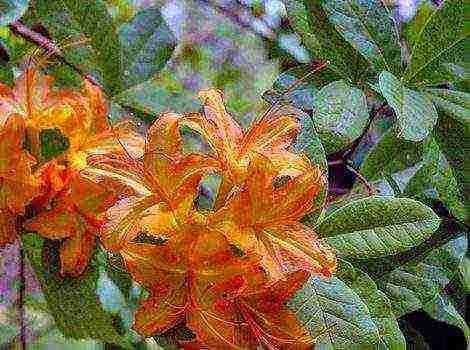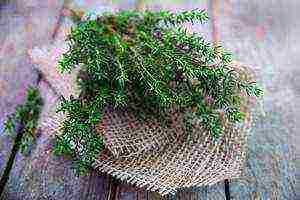Content
Juno (Latin Juno) is a genus of bulbous perennial plants of the family Iris. The name was given to the genus by the famous Austrian botanist L. Trattinnik in honor of the goddess, patroness of women and family, Juno. He also singled out these plants into a separate genus, justifying this by the difference in the stages of development. Until now, some gardeners mistakenly attribute Juno to irises.
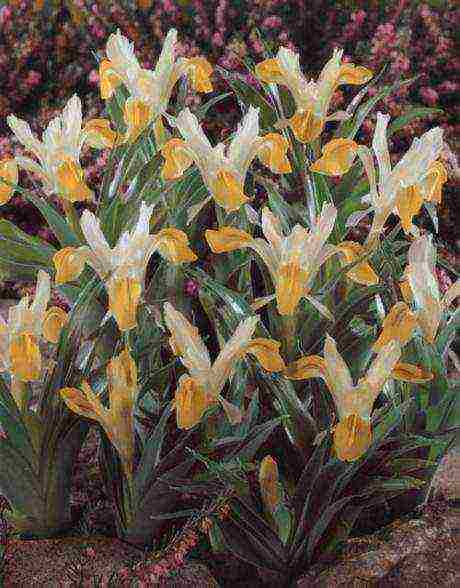
Juno of Bukhara
Description
Juno is a small-bulbous ephemeroid, up to 40 cm high (usually 10-15 cm). Bulbs of several fleshy, separate scales, covered with film scales on top. The roots are spindle or filamentous, viable in the resting stage of the plant (they do not die off, like in many other bulbous). The leaves are grooved, crescent or lanceolate, alternate, sessile, glossy, green.
The peduncle is powerful, sometimes shortened, bears up to 7 flowers. Flowers are formed in leaf axils in 1-2 and at the top of the flowering stem. The color of the flowers is varied, often two-colored. Perianth lobes 6. They are located in two annular rows, grow together below and form a pronounced tube. The outer lobes are horizontally located or lowered, often with a marigold, in the center with a ridge contrasting in color. The inner lobes are bent or extended, several times shorter than the outer ones. Lower ovary. The column is dissected into three petal-like vertical stigmas. The fruit is a triangular capsule.
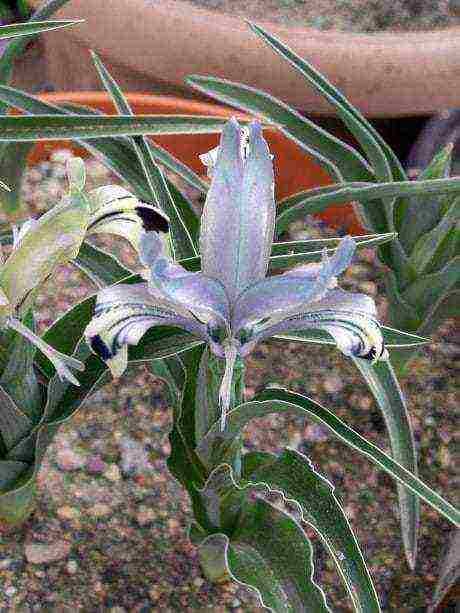
Juno Kushakevich
The area of growth is the mountain slopes and desert steppes of Iran, Afghanistan, the Mediterranean, Central and Asia Minor. Depending on the species, flowering occurs from February to May, the dormant stage from June. In some species, flowering outstrips the development of leaves.
Types used in floriculture
The genus includes over 50 species, characterized by varying degrees of decorativeness, color and growing season. Not all types of juno have taken root in culture.
Yu gorgeous (lat. J. Magnifica) - the most widespread species in horticulture. Enlarged bulb (3 cm or more in diameter). The stem is powerful, up to 50 cm in height, bears up to 7 flowers. Leaves are glossy, faded green, rough. The flowers are large, from white to light purple. The plates of the outer lobes with four characteristic purple marks at the base and a bright yellow spot. The ridge is light, weakly expressed. The flowering period is April, May.
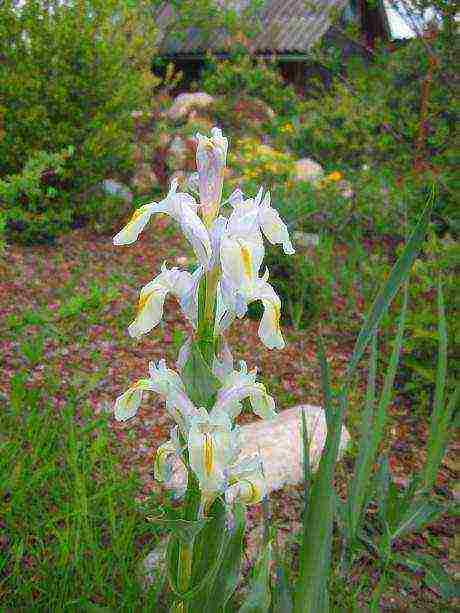
Juno is gorgeous
South Bukhara (lat. J. Bucharica) is a late flowering plant (blooms in April for 2-3 weeks). Peduncle up to 30 cm, with 4-5 buds. Flowers up to 7 cm in cross section, colored in various shades of yellow. The extended marigold of the outer lobes forms an ovoid plate. The crest is dark yellow, serrated. The inner lobes are with elongated pointed plates, much lighter than the outer ones (often almost white). Widespread species in horticulture.
South Caucasian (lat. J. Caucasica) - peduncle 20-25 cm, on average bears 2-3 flowers. Leaves are green with a bluish tint; swirling or outstretched. The flowers are light yellow or greenish-yellow, sometimes purple, up to 5 cm in cross section. The ridge is bright yellow, pronounced. It blooms in early spring.
Yu orchid (lat. J. Orchioides). The bulbs are small, up to 2.5 cm thick. The stem is five-flowered, with noticeable internodes, 20-30 cm high. The flowers are yellowish; the plates of the outer lobes with a large (sometimes for the entire plate) bright yellow spot and purple marks along the edge; the crest is dissected in the lower part, dark yellow. The flowering period is April, May. Very decorative and featured in many international horticultural catalogs.

Yu substitute (lat. J. Vicaria) - the stem reaches 50 cm in height, powerful, bears about 5 odorless flowers. Outer plates are white or light yellow, with bright spots along the edge of the ridge. The ridge is light, wavy, solid. The inner lobes are light purple.The flowering period is April, May. It has proven itself well as an open field culture in northern latitudes.
Y. Nikolay (lat. J. Nicolai) - a kind of early flowering period (end of February - March). The bulbs are small, up to 2 cm in diameter. The stem is poorly developed, bears up to five large flowers. Flowering outstrips the development of leaves. The plates of the outer lobes are dark purple, speckled, the crest is bright yellow; inner lobes with a pale pink blunt plate.
Yu blue (lat. J. Coerulea). The peduncle is dwarf (up to 7 cm), with dense foliage and subtle internodes. The flowers are large, light blue or blue. The comb is yellow or whitish, solid. The flowering period is March, April.
Photo gallery of species Growing and care
Location. For growing and caring for Juno, well-lit, elevated, areas protected from northern winds are needed.
The soil. Light, well-drained loams are preferable. Able to grow on stony clay soils.
Watering. During the growing season, as well as in the fall when planting juno, it is moderate. In the resting stage, watering is undesirable. When moisture stagnates, the roots rot and, as a result, the plant dies.
Landing. Juno bulbs are planted in early autumn, deepening 6-8 cm into the soil. To maintain abundant flowering every 5 years, the plant needs a transplant (planting daughter bulbs).
Important! When transplanting, it is especially worth handling the fleshy roots. At their base (at the bottom of the bulb) there are renewal buds, their damage is fraught with the death of the plant.
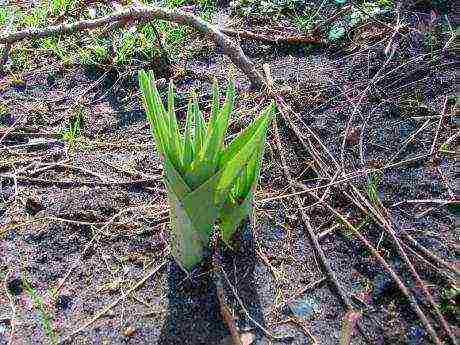
Juno at the beginning of the growing season
Top dressing. In early spring, nitrogen and potash fertilization is recommended. Before flowering and a week after - with complex mineral fertilizers.
Reproduction
Juno reproduces in several ways:
• seed;
• dividing the bulb;
• daughter bulbs.
The seeds ripen at the end of the growing season (end of June). To grow juno from seeds, they are harvested before the bolls crack, dried and sown in the fall immediately to a permanent place. Seeds up to 20 years old retain the ability to germinate. Sown, they can sprout in 2-3 years. The flowering of plants from seeds occurs in 4-5 years. Self seeding is possible.
The signal for digging the bulbs for division (every few years) is withered leaves. The bulbs are carefully dug out, trying to preserve the roots, cleaned from the ground, divided and sorted. Sprinkle with crushed charcoal the place of disconnection, dry it for half an hour and plant it in a previously prepared place.
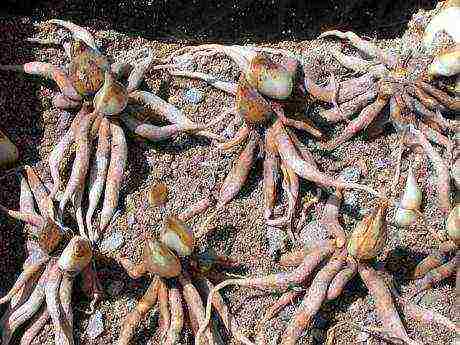
Juno bulbs with roots
If there is a need to overexpose the planting material for a short time, then store it in a cool room, sprinkled with sawdust.
For a faster flowering plant, reproduction is possible by dividing the mother bulb. To do this, it is cut, leaving on each division a part of the bottom with roots and a bud of renewal. The cut site is rubbed with crushed activated carbon or treated with brilliant green or iodine.
Diseases and pests
Of the pests, the most dangerous for the juno are rodents (mice, voles, moles), as well as the root wireworm.
Diseases: gray rot, rust, fusarium. When damaged, the leaves of the plant wither earlier than usual, and brown spots appear on the bulbs. Diseased plants must be destroyed outside the site. For prophylaxis, the bulbs are kept in a weak solution of potassium permanganate or other fungicidal solution.
Use in landscape design
Juno is used for the early spring decoration of the still sleeping garden. It is planted along the paths, in rockeries and on alpine hills. Plants appear self-sufficient in single plantings, forming dense clumps, and in partnership with other early flowering plants.

Juno in composition
Partners will be: snowdrops, crocuses, scyllas, Pushkinia, etc. Types of early and very early flowering period are used for forcing.
The subgenus of iris Juno (Juno) includes 57 species of bulbous perennial plants from the family Iris.In their appearance, they are very similar to irises, although there is no close relationship between them. The genus Juno was described in 1902 by Sir Michael Foster (1836-1907), an English professor of physiology who was known for his passion for irises. This is no coincidence, since the culture is famous for the variety of shapes and shades of flowers.
Plants can be found in the Middle East, Central Asia and North Africa. Many of the species are difficult to cultivate in our gardens. The exception is Juno of Bukhara, which grows in the wild on the rocky mountain slopes of the northeast of Afghanistan, Tajikistan and Uzbekistan, and the view is magnificent Juno. Due to their decorativeness and ease of care, these representatives of the subgenus are popular with gardeners.
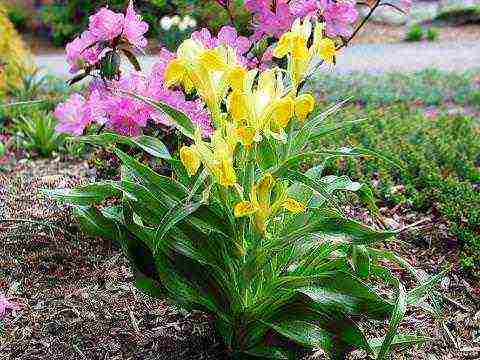
Bulbous perennials are dormant in summer and produce foliage in early spring. Flowering lasts 7-10 days in April-May. Crescent-shaped glossy leaves are arranged alternately on an erect stem. At the end of the peduncle, a yellow, blue or white fragrant flower develops in the leaf axils. The foliage remains until the beginning of summer, and then dies off with the stem.
The crop requires well-drained, neutral, loamy soils and a sunny spot. The oriental beauty loves heat and drought, so excess moisture leads to rotting of the bulbs. When planting, choose an elevated area so that melt and rainwater does not accumulate around the plant. Top dressing with nitrogenous fertilizer is carried out in the spring at the stage of bud setting and after flowering.
Juno reproduces by seed and by dividing the bushes after they have grown. Delenki are planted to a depth of 5 cm, trying not to damage the fleshy roots, on which the points of growth renewal are located. Add coarse sand to the soil before planting for good permeability and some compost.
The seeds require stratification, so they are stored in a refrigerator at -5 to -10 ° C for several weeks.
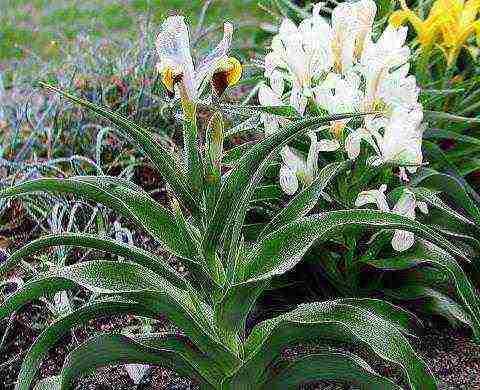
Sow in January - February for seedlings in a prepared substrate of compost and sand 50:50. Sowing in late autumn under snow also gives a good result, sprouts appear already in early spring. With this method of reproduction, we will get an adult flowering plant in 3-4 years.
In garden design, Juno is ideal for decorating alpine slides and rockeries. Other spring flowering plants will become her companions: daffodils, chionodox, spring, aubrieta, lumbago, primrose, crocuses and hyacinths.
Did you like the article? Vote!
1 1 1 1 1 Rating 5.00
The Iris family is capable of surprising with its diversity. The range of irises is by no means limited to your favorite bearded, Siberian or Japanese irises. Among the relatives of incomparable garden stars, sometimes you can find unexpected and very original plants. One of these rare exotics is the beautiful Juno. Capricious and specific in terms of agricultural technology, she prefers to settle in rocky gardens. Juno is one of the earliest flowering bulbous irises.
Bukhara iris (Iris bucharica) or Juno bucharica (Juno bucharica)
Stone-loving "not so" irises
Juno is one of the most original plants in the Kasatikov family. Their classification is very confusing, since certain species constantly "migrate" to the genus of Irises and back, which is the cause of considerable confusion. But junoes are not close relatives of the most popular rhizomatous irises, radically different from them in most characteristics. The plant got its name in honor of the goddess Juno - the patroness of women and the legendary goddess of the moon.
Juno (Juno) - a representative of perennial bulbous, medium-sized, but seemingly quite impressive due to densely leafy stems, plants... In the development of Junon, periods of long summer dormancy and short spring vegetation, lasting only 3-4 weeks, are pronounced. Juno has time to appear in April, bloom in mid-spring and quickly disappear, without spoiling the look of their drying leaves, flower beds that have just entered into a riot of colors. In fact, this is a unique bulbous, the decorative period of which is so limited in time that it turns the juno into an exclusive, unprecedented decoration. This plant is planted exactly as an original accent, exotic, which not everyone can admire.
The maximum height of Junon is limited to 50 cm, but plants with a height of 10-30 cm are much more common.... Bulbs consist of non-accrete fleshy scales (from 3 to 5) and dry film scales. The roots are powerful, cord-like, most often thickened, not dying off during a dormant period. Juno leaves bend in a crescent shape, hugging the shoots, alternating and creating a bizarre and massive silhouette. Narrow-grooved or broadly grooved, Juno leaves always flaunt with a glossy sheen, emphasizing the deep green tone. The color of the foliage changes from a light bluish-blue shade at the bottom of the shoots to a bright light or medium green at the top. Single flowers bloom on the shoots (at the top and in the axils of the leaves). Most often, one plant produces 2-4 flowers, but sometimes up to 7 flowers bloom on the shoots. Fragrant, with a six-lobed perianth and a pronounced tube, flowers only vaguely resemble irises. The outer perianth lobes are always decorated with a marigold, turning into a winged plate, several times larger than the inner lobes extended to the sides or bent down.
Junon always blooms in mid-spring.... Usually the plant is "tied" to April, but the growing season of this bulbous one directly depends on the characteristics of the weather during the year.
Junon's color palette is very diverse, but only in shades: the flowers of this plant are always painted either in white and cream, or in different tones of yellow and light purple.
Juno caucasica
Types of Juno
Despite the fact that earlier more than fifty plants were combined into the genus Juno, today most of the species have been re-qualified as irises. Only 3 out of 5 types of junon are used as ornamental plants. All of them are united by beautiful foliage and spectacular white or yellow flowering, comparative unpretentiousness and endurance. Juno is naturally found throughout Eurasia, but the spread in their ranges is quite large. Some of the species are North African. These plants live in dry steppes and on mountain slopes, which largely determines the specifics of their cultivation.
Juno Caucasian (Juno caucasica) is a compact yellow-flowering species up to 25 cm high. Small, flat bulbs up to 2 cm wide produce thickened roots and strong shoots, crowned with a few-flowered inflorescence. The leaves are crowded or widely spaced, hugging the stem, gray-green. The flowers are asymmetrical, up to 5 cm in diameter, with long, elegant and short inner marigold lobes of the perianth. The pale yellow color is accentuated by a bright spot on the outer petals. This is one of the earliest flowering irises, which can bloom even at the end of March in favorable weather.
Juno Foster (Juno fosterana) is a compact plant up to 20 cm high with a centimeter elongated bulb, surprising with its huge amount of brown dry scales. Stems with contiguous, sickle-curved leaves with a bordered edge look spectacular and unusual. On each shoot, from 1 to 4 flowers bloom, the diameter of which reaches 5 cm. The perianth tube is long, up to 4 cm, the outer lobes are pale yellow, the inner ones are pale purple. This is the only "multi-colored" species of genuine Juno.
Juno of Warile (Juno waryleyensis) - a very ornamental plant with larger, up to 2.5 cm bulbs and stems about 30 cm tall, flaunting widely spaced leaves and symmetrical internodes. Unlike other Juno, the Worilean leaves are not dark, but light, with a beautiful border around the edge and a rough surface.The flowers are unscented, but with a beautiful purple color, the shades of which can vary from dark to light. The perianth with a long tube flaunts with a spectacular marigold and a velvety dark plate on the outer lobes and deep purple inner lobes.
Juno caucasica
Two other types of Juno are considered exceptional rarity - Juno porphyrochrysa and Juno issica.
Genuine Juno are very rarely found on sale, with the exception of the Caucasian Juno. But more and more often in the catalogs of exotics there are hybrid junons obtained by crossing and breeding plants, which are better adapted to the conditions of regions with harsh winters and are more promising.
But those Junoes, which were transferred to the Iris family, are much more widespread and popular. So, it is with the name "Juno" that the most famous of the early-flowering bulbous irises - Bukhara iris is associated.
Iris Bukhara (Iris bucharica (synonym - Juno bucharica)) is a bulbous perennial, the bulbs of which are limited to a maximum of 2 cm in height and diameter. Stems from 15 to 30 cm high are covered with sickle-curving, light green grooved leaves, narrowed at the top. On each stem, up to 5 flowers with a diameter of about 7 cm bloom. The inner perianth lobes are white, sharp, with a rhombic-three-lobed plate. The outer lobes are painted in dark or light yellow tones, flaunting a marigold gradually expanding into an elongated plate. Bukhara iris seems delicate and watercolor. Flowers appear in late April, contrast beautifully with glossy leaves, flowering lasts up to 3 weeks.
Bukhara iris (Iris bucharica) or Juno bucharica (Juno bucharica)
Other plants reclassified back to irises continue to spread under the old name Juno.:
1) Orchid iris or Juno Orchid (Iris orchioides, formerly Juno orchioides) is a very decorative and popular bulbous perennial. Stems with fairly large internodes reach 30 cm in height. Up to 5 flowers bloom in the leaf axils. Leaves are bordered, light, rough. The pale yellow flowers are very effective due to the bright golden color of the plates with purple strokes, the dark ridge of the outer lobes and the sharp three-lobed plate - the inner ones. Orchid iris blooms in early spring, it is considered a very valuable and exclusive plant.
2) Dwarf iris (Iris pumila, synonym - Juno blue (Juno coerulea)) is a striking white-lilac look, in which the flowers contrast especially beautifully with the foliage. The dwarf iris bulbs do not exceed 2.5 cm in diameter. The leaves have a bright, rich green color, they sit closely together, internodes are practically invisible. On each peduncle, up to 5 flowers bloom, the shoots themselves are low, only up to 7 cm. Lilac-blue flowers up to 7 cm in diameter adorn with lanceolate light inner lobes and twice as large - outer ones, on which a non-pterygoid marigold with almost parallel edges is clearly visible. Dwarf iris blooms in the middle of spring, it looks fresh and bright.
3) Iris substitute (Iris vicaria or Juno substitute - Juno vicaria)) - a plant with larger, up to 3.5 cm bulbs, stems capable of growing up to half a meter and light glossy foliage, on which a yellowish tint at the base and bluish tint is noticeable at the edge of the leaf plates. The flowers are non-aromatic, pale, creamy lilac, with a dark yellow spot and crest. It is considered one of the easiest to grow bulbous irises for the middle lane.
These are plants with the same leafy shoots, but slightly different flowering, mainly of a two-color palette and some differences in vegetation. Such "Juno" is much easier to grow, they thrive in any loose soil, but still their requirements are almost identical.
Iris replacing (Iris vicaria) or Juno replacing (Juno vicaria)
In the design of the garden, Juno is used:
- on the alpine slides;
- in rockeries;
- to introduce contrasts with carpet plants and boulders in rocky gardens;
- in landscape groups with spring stars;
- in the foreground of flower beds;
- for decoration of southern slopes and terraced gardens;
- for decoration of the front edge of groups and hedges with flowering shrubs;
- as a spring decoration under large trees;
- in a pot culture;
- in mobile rock gardens;
- as a cut and greenhouse plant;
- for distillation;
- as an indoor garden culture.
Best partners for Juno: muscari, hyacinths, crocuses, daffodils, scilla, snowdrops, chionodox, anemones
Conditions Needed by Junons
The key to success in growing Juno in the garden, especially in the middle lane, is creation of conditions close to natural areas of plant growth... Climate change is also bringing our conditions closer to those loved by Juno - cold winters, dry summers and wet springs. For juno, they must provide warm, secluded, protected places, reliably protected from winds and drafts by large plantings. But at the same time, not shaded ones are suitable for these plants, but only well-lit areas... True, it should be borne in mind that even when planting under large trees, the juno will enjoy the sun during the growing season, because usually, before the wither of the juno, woody and shrubs just release their leaves.
Particular attention must be paid to the characteristics of the soil. Juno do not tolerate stagnant water and are accustomed to growing in rocky ground. Drained, light areas of rockeries and rock gardens are ideal for them., but not elevations, but hollows or relatively low places in which there is no risk of increased freezing. On flower beds and in garden ensembles, light loams are better suited for Junons, which will completely replace the usual stony-clay soils. At the slightest risk of water stagnation in the area where the Juno is planned to be planted, it is better to immediately lay additional drainage.
Growing in containers is considered an easier way, because it is easier for Junon to provide a dry summer dormant period.... When planting in pots and containers, Juno requires a sunny location and a versatile lightweight substrate with the addition of a double portion of sand and a small amount of organic fertilizers. Capacities for juno are selected large, deep, so that fleshy roots can freely develop in them and a very high drainage can be laid.
Iris replacing (Iris vicaria) or Juno replacing (Juno vicaria)
Juno's landing
Junos are planted a little later than tulips - in mid-September... When planting, you must be very careful with the fleshy roots, trying to cause as little damage as possible even to the thin filamentous roots. Junos are planted in individual planting holes, placing the bulbs at a depth of 5-8 cm (despite the small size, a higher planting carries the risk of losing them in the first winter). The distance from neighboring plants is at least 30-40 cm, and preferably half a meter (these bulbs are actively growing). On top of the planting, it is advisable to mulch with any available materials.
Juno's containers are planted at the same depth... But at the bottom of the tanks, a high layer of large drainage from 1/3 to? the height of the container.
Juno care
Despite the status of a semi-wild and unpretentious plant, Juno will require additional watering... Plants must be watered during dry periods in the spring and fall. When the plant enters the summer dormant period, it is not watered, and with too heavy rainfall, it is additionally protected from excess moisture by special greenhouses. If there is no way to protect the plants from summer waterlogging, no measures were taken to drain the soil, then after the foliage wilted, you can dig up the bulbous ones and save them until planting in September in large containers, covering them with light soil or sand (the roots must be handled very carefully).Since the growing season of juno is very short, additional watering will not cause difficulties. Top dressing is carried out only for potted Junons (during the growing season - every week). Other maintenance measures are not needed, with the exception of young crops, which need protection from weeds.
These plants need regular rejuvenation and transplantation with a frequency of 1 every 4-5 years due to the tendency to actively grow and thicken to the detriment of flowering. In this case, they are dug up after wilting, separated, and after summer they are planted in a container in a new place in September.
Due to the very short growing season, pests and diseases of Juno are not terrible. But with waterlogging, especially in summer, the plant is extremely sensitive to rot... Juno bulbs rarely attract rodents.
Iris dwarf (Iris pumila) or Juno blue (Juno coerulea)
Breeding Juno
This bulbous can be obtained both vegetatively and from seeds.
Juno's daughter plants form quite actively... When dense "nests" of juno are formed, individual bulbs can be dug up and separated, each of which is planted as an independent plant. The "nests" are planted after the end of the growing season and the death of the leaves. During separation, the roots are handled with extreme care, as the regeneration buds at their base are very easy to damage. The dug up bulbs are stored in sand or light soil in containers until mid-September.
Juno seeds are sown in the fall. Shallow sowing with mulching plantings for the winter allows you to preserve fragile shoots in the first spring. Young junos require intensive care - protection from weeds, gentle loosening of the soil, watering in spring and autumn. Bulbs bloom in the third or fourth year. Transplanting to a permanent place is carried out in the second or third year, in the fall, digging up the plants in the spring after the leaves wilted and keeping them in containers until planting. Juno seeds remain viable for 20 years.
Juno also reproduce dividing the bottom of the onions - separation of the roots with a bud at the base, from which an independent plant will develop.
Juno flower is a bulbous perennial plant belonging to the iris family.
The genus of the plant contains about 46 species, distributed mainly in Central Asia, as well as in Transcaucasia, Kazakhstan, Northern Afghanistan, Asia Minor and Western Asia and Iran. A large number of species grow in natural conditions in the foothills on stony-clay soil. Only a few species grow on the upper mountain belts. As a cultivated plant Juno flower still little known, but in flower books sometimes Juno is defined as a separate group of irises. Juno flower can be grown without problems in the central and southern regions of Russia.
Description... By its structure Juno flower looks like xyphyum. Plant height 10..50 cm. Leaves broadly or narrowly grooved, mostly sickle-bent. The flower shoot is leafy and well developed. The axils of the upper leaves are decorated with 1..5 flowers. Most species have fragrant flowers. Color of flowers: white, pale yellow, green, violet, yellow with a touch of orange color, purple. All colors are combined in a wide variety of tones. The flowers reach 3..9 cm in diameter. The fruit is a tricuspid capsule. Seeds are angular and spherical. Small bulbs 1.5..2 to 3.5 cm, consisting of 3-5 non-accrete fleshy and outer membranous scales. Juno's roots are spindle - or cord-like, thickened, and sometimes filiform. At the bottom of the bulb, where the roots grow, are the buds of renewal. The roots of the flower do not die off during the summer dormancy. The increased growth and development of the plant occurs in the spring. For the rest of the year, Juno is dormant.
Growing... Juno flowers are primroses; when grown in culture, they are not whimsical. A warm, sunny, but well-sheltered place is necessary for planting.The plant thrives on both heavy and light soils with good drainage. The best option would be light loam. An important condition for the long-term cultivation of juno is the soil, which should not be waterlogged, be nutritious and contain a large percentage of humus.
Landing occurs in late August or early September. The soil is dug to a depth of 25..30 cm, after adding humus (10..15 kg / sq. M) and mineral fertilizer (40..50 g / sq. M). The bulbs, very carefully, without damaging the roots, are planted to a depth of 10 cm, medium-sized, and large ones to a depth of 15 centimeters.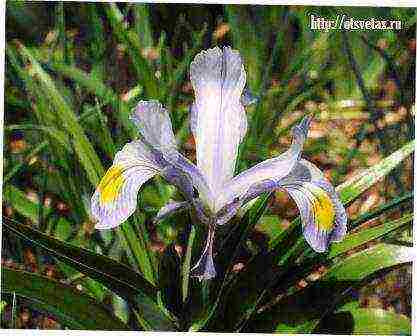
Care... In anticipation of winter, the planted bulbs are covered with a layer (10..15 cm) of peat and dry leaves. The shelter is removed after the snow melts. The first feeding is carried out immediately, applying nitrogen-phosphate fertilizers (ratio 3: 1), that is, 60 grams per 1 sq. meter. The second feeding is performed after 2-3 weeks (50 g / sq. M). The third top dressing consisting of phosphorus, nitrogen and potassium (1: 3: 3) is carried out after flowering (100 g / sq. M).
Bloomrequires close attention. The main requirement for flowering is soil moisture, even a slight drought should not be allowed. After the leaves of Juno turn yellow, the bulbs are carefully dug out without damaging the roots. The dug out bulbs are dried in a place free for air flow for 3-5 days. Then they are cleared of soil and added to dry sand for summer storage.
Reproduction Juno is done with seeds. But to obtain them, artificial pollination is necessary. Sowing seeds is carried out immediately after they are harvested. It should be taken into account that only Yu. Bukhara blooms in the second year after sowing the seeds, and most plant species will bloom only for 4-5 years.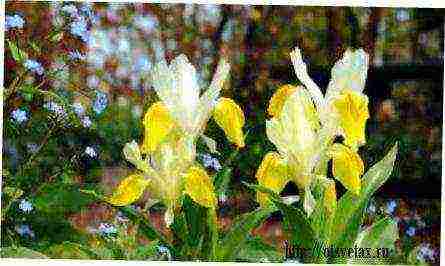
In terms of cultural content Juno flower reproduces by means of daughter bulbs. Thickened roots are used to accelerate vegetative reproduction. To do this, during the dormant period, the thickened roots are separated with a piece of onion and buried in the sand. The bud of renewal, located in the sinus between the root and the bottom, develops into a small bulb that blooms for 3-4 years. This method of reproduction will be crowned with success only when maintaining the moisture content of the sand at the same level. The sand should not be waterlogged and should not dry out.
Distillation... In order to drive out the Juno plant, large and healthy bulbs are selected in the fall and, using light, nutritious and loose soil, are planted in pots or bowls. The planted bulbs are stored in a winter garden or on a loggia at a temperature of 5..10 ° C. The substrate must always be moist. If these conditions are met, the plant will bloom in January or February. A prerequisite for good flowering is mineral fertilizing (flower fertilizer). The first feeding is carried out at the beginning of the growing season, the second during the flowering period. Blooming juno requires abundant watering.
The most popular outdoor varieties of Juno.
| View | H. color-nose (cm) | Flower | Wed blooming (month) | ||
| number | coloration | diameter | |||
| Juno of Bukhara | 15-30 | 4-6 | yellow | 6-7 | 4-5 |
| Yu Oshera | 12-15 | 3-6 | Blue with yellow | 6-7 | 2-3 |
| South Caucasian | 10-25 | 2-5 | light yellow | 3-5 | 4-5 |
| J. Foster | 5-10 | 1-4 | Pale yellow pale purple | 4-5 | 3 |
| Yu Gerbera | 25-30 | 2-5 | blue | 5-6 | 4 |
| Yu gorgeous | 25-30 | 2-7 | lilac | 5-7 | 3-4 |
| Y. Nikolay | 5 | 1-3 | Yellow, crimson, violet-pink | 5-7 | 3 |
| Yu orchid | 15-25 | 1-5 | Pale yellow, yellow | 3-6 | 4-5 |
| South Persian | 15-20 | 2-3 | Blue with yellow crest | 4-6 | 2-3 |
| J. Rosenbach | 5-10 | 2-3 | violet | 5-7 | 4 |
| Yu Tubengera | 10-15 | 1-3 | Yellow with purple | 5-6 | 4 |
| Yu substitute | 20-50 | 2-5 | Light purple with yellow | 5-7 | 4-5 |
| J. Warley | 20-50 | 2-5 | Purple with white | 5 | 3-4 |
| J. Willmott | 10-20 | 4-6 | White and violet blue | 5-7 | 4-5 |
Pests and diseases... The plant is rarely affected by diseases and pests. But, there are exceptions, and the juno suffers from onion hoverflies, onion root mites, gray rot, fusarium.
The onion hoverfly is a dirty yellow larva that feeds on the bulb. Pest control measures are scrupulous inspection of the bulbs before storage. Etching the bulbs with karbofos before planting.
The onion root mite damages the bottom of the bulb, as a result of which it begins to rot. Pest control measures:
1. Increased agricultural technology.
2. Storage in dry conditions.
3. Using healthy planting material.
4. Etching of bulbs with karbofos, rogor before planting.
Excess nitrogen, high humidity, and mechanical damage cause gray rot. With the disease, bulbs, peduncles, leaf ends, as well as their bases (gray bloom) are affected.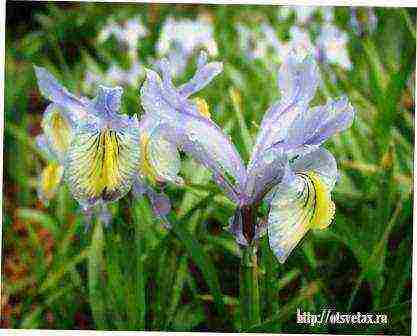
How to prevent the appearance of gray mold? The plant is grown on a drained soil with a large amount of potassium and phosphorus, planting in sunny places. Damaged flowers are promptly removed by watering with foundation, euparen, etc.
Fusarium occurs when a plant is grown in high humidity. Rotting areas appear on the bulb (in most cases on the bottom) as a result of which the roots die off. With a disease, a white-pink bloom appears on the bulb. The fight against the disease consists in etching the bulb with suspensions of toxin, foundation, etc. After pickling, the bulbs are well dried.
The Juno flower bears the name of the goddess Juno, the patroness of married women.
Map of site.
